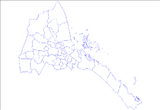Kerkebet Subregion
Kerkebet | |
|---|---|
Subregion | |
 | |
| Country |  Eritrea Eritrea |
| Region | Anseba |
| Capital | Kerkebet |
| Time zone | UTC+3 (GMT +3) |
Kerkebet Subregion (Tigrinya: ንኡስ ዞባ ከርከበት) or Carcabat District is a subregion in the northwestern Anseba region (Zoba Anseba) of Eritrea. Its capital lies at Kerkebet (Carcabat).
Overview
The Kerkebet Subregion, situated in Eritrea's Gash-Barka region, is a notable area with a unique blend of natural resources, agricultural potential, and historical significance. Known for its strategic location, Kerkebet is bordered by several other key regions and is traversed by vital rivers such as the Barka and Anseba, which contribute to the area's agricultural viability.
Geography and Climate
Kerkebet is characterised by its arid environment, with sparse vegetation and a harsh climate typical of the wider Gash-Barka region. Despite these challenging conditions, the area benefits from the presence of the Kerkebet Dam, which has a significant capacity of 400 million cubic meters. This dam is pivotal in transforming the otherwise dry landscape into a thriving agricultural zone, making it a critical component of Eritrea's agricultural strategy.
Agricultural Development
The agricultural potential of Kerkebet has been harnessed through the establishment of large-scale farming projects. The Eritrean Crops and Livestock Corporation has spearheaded these initiatives, focusing on sustainable development and climate-smart agricultural practices. The Kerkebet agro-project is a prime example of this, where vast tracts of land are under cultivation, producing crops like maize, sorghum, and groundnuts. The project supports thousands of farmers, many of whom have migrated from other regions of Eritrea, bringing with them diverse agricultural expertise.
In addition to crop production, the area is also a hub for livestock rearing, further enhancing its importance to the national economy. The development of irrigation systems, energy supply, and other infrastructure has been instrumental in ensuring the success of these agricultural ventures, making Kerkebet one of the most productive regions in the country.
Historical and Cultural Significance
Kerkebet is not only significant for its agricultural contributions but also holds historical and cultural importance. The region has been a site of historical events, particularly during Eritrea's struggle for independence. Its proximity to towns like Keren, which have rich historical backgrounds, adds to the cultural depth of the area. Moreover, the road networks connecting Kerkebet to other parts of Eritrea are crucial for facilitating trade, movement, and the dissemination of goods produced in the region.
Challenges and Future Prospects
Despite its successes, the Kerkebet Subregion faces several challenges, including the harsh climatic conditions and the need for further infrastructural development. However, with ongoing efforts to expand irrigation, improve land management, and increase the involvement of local communities, the future of Kerkebet looks promising. The region's potential for further agricultural expansion and its strategic importance make it a key area for Eritrea's ongoing development initiatives.
Kerkebet's transformation from a barren landscape to a flourishing agricultural hub is a testament to the resilience and determination of its people and the strategic vision of Eritrea's development policies.
References
- Eritrea Ministry of Information. (n.d.). Kerkebet agro-project: A boom to agricultural production (shabait.com)
- Eritrea Youth Organisation. (n.d.). Journey to Kerkebet
- Subregions of Eritrea
- v
- t
- e
 Subregions of Eritrea by region
Subregions of Eritrea by region
 Eritrea portal
Eritrea portal
16°06′N 37°25′E / 16.100°N 37.417°E / 16.100; 37.417
 | This Eritrea location article is a stub. You can help Wikipedia by expanding it. |
- v
- t
- e











